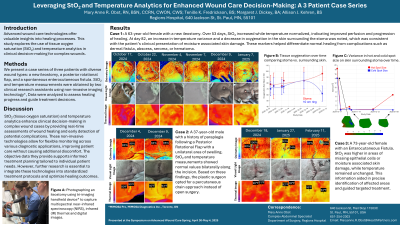Case Series/Study
(CS-113) Leveraging sto2 and Temperature Analytics for Enhanced Wound Care Decision-making: A 3-patient Case Series
Friday, May 2, 2025
7:45 PM - 8:45 PM East Coast USA Time

Tenille Fredrickson, Bachelor of Science – Clinical Research Assistant, General Surgery, Regions Hospital; Margaret Dickey, BA EMT-B – Clinical Research Assistant, General Surgery, Regions Hospital
Introduction: Advanced wound care technologies offer valuable insights into healing processes. This study explores the use of tissue oxygen saturation (StO2) and temperature analytics in clinical decision-making for complex wounds.
Methods: We present a case series of three patients with diverse wound types: a new ileostomy, a posterior rotational flap, and a spontaneous enterocutaneous fistula. StO2 and temperature measurements were obtained by our two clinical research assistants using non-invasive imaging technology. Data were analyzed to assess healing progress and guide treatment decisions.
Results: Case 1
Female (63 yrs) with a new ileostomy. Over 54 days, StO2 increased while temperature normalized, indicating improved perfusion and progression of healing. These markers helped differentiate normal healing from complications such as dermal fistula, abscess, seroma, or hematoma.
Case 2
Male (37 yrs) with a Posterior Rotational Flap with unilateral area of swelling: StO2 and temperature measurements showed normal values bilaterally along the incision. Based on these findings, the plastic surgeon opted for a percutaneous drain approach instead of open surgery.
Case 3
Female (73 yrs) with an Enterocutaneous Fistula: StO2 was higher in areas of missing epithelial cells or moisture associated skin damage, while temperature remained unchanged. This information aided in precise identification of affected areas and guided targeted treatment.
Discussion: StO2 (tissue oxygen saturation) and temperature analytics enhance clinical decision-making in complex wound cases by providing real-time assessments of wound healing and early detection of potential complications. These non-invasive technologies allow for flexible monitoring across various diagnostic applications, improving patient care without causing additional discomfort. The objective data they provide supports informed treatment planning tailored to individual patient needs. However, further research is essential to integrate these technologies into standardized treatment protocols and optimize healing outcomes.
Methods: We present a case series of three patients with diverse wound types: a new ileostomy, a posterior rotational flap, and a spontaneous enterocutaneous fistula. StO2 and temperature measurements were obtained by our two clinical research assistants using non-invasive imaging technology. Data were analyzed to assess healing progress and guide treatment decisions.
Results: Case 1
Female (63 yrs) with a new ileostomy. Over 54 days, StO2 increased while temperature normalized, indicating improved perfusion and progression of healing. These markers helped differentiate normal healing from complications such as dermal fistula, abscess, seroma, or hematoma.
Case 2
Male (37 yrs) with a Posterior Rotational Flap with unilateral area of swelling: StO2 and temperature measurements showed normal values bilaterally along the incision. Based on these findings, the plastic surgeon opted for a percutaneous drain approach instead of open surgery.
Case 3
Female (73 yrs) with an Enterocutaneous Fistula: StO2 was higher in areas of missing epithelial cells or moisture associated skin damage, while temperature remained unchanged. This information aided in precise identification of affected areas and guided targeted treatment.
Discussion: StO2 (tissue oxygen saturation) and temperature analytics enhance clinical decision-making in complex wound cases by providing real-time assessments of wound healing and early detection of potential complications. These non-invasive technologies allow for flexible monitoring across various diagnostic applications, improving patient care without causing additional discomfort. The objective data they provide supports informed treatment planning tailored to individual patient needs. However, further research is essential to integrate these technologies into standardized treatment protocols and optimize healing outcomes.

.jpg)